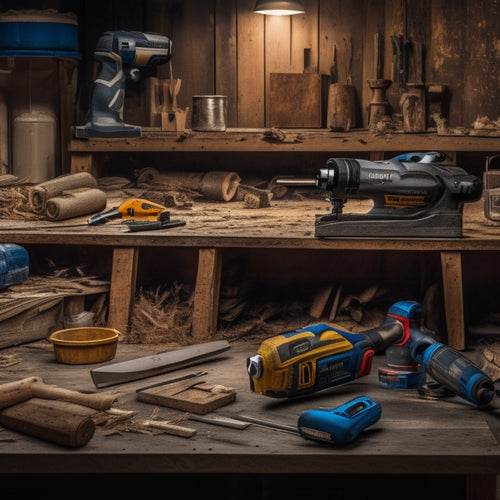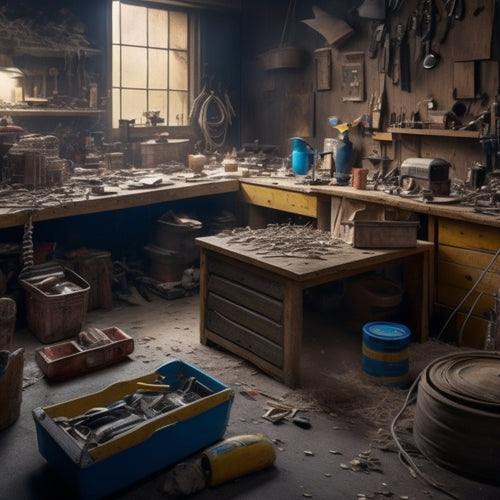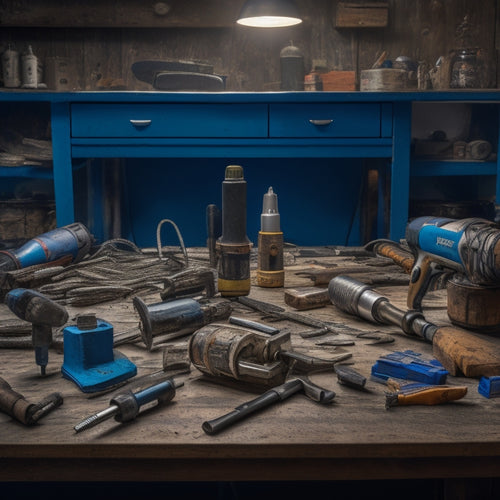
Why UK Renovators Must Follow Safety Guidelines
Share
As a UK renovator, you're not just responsible for meeting building codes, but also for ensuring your own safety and the well-being of others on site, making adherence to safety guidelines essential to avoid injuries, fatalities, and costly legal repercussions. You must follow strict regulations to prevent exposure to hazardous chemicals, handle materials safely, and prepare sites properly. Failure to do so can have devastating consequences, including environmental damage and health risks. By understanding the importance of safety guidelines, you'll be better equipped to navigate the complexities of renovation projects and create a safer working environment - and there's more to discover about how to do it right.
Key Takeaways
• Adherence to UK safety regulations prevents exposure to hazardous chemicals and ensures a safe working environment for renovators and occupants.
• Failure to comply with safety guidelines can result in serious injuries, fatalities, and legal liabilities for UK renovators and their companies.
• Renovators must follow safety guidelines to minimize environmental damage and health risks associated with hazardous materials like asbestos and lead paint.
• UK safety regulations provide a framework for renovators to identify and mitigate potential hazards, reducing the risk of accidents and near-misses.
• Regular inspections, training, and emergency response planning are essential for UK renovators to ensure compliance with safety guidelines and prevent devastating consequences.
Concrete Crack Filling Safety Regulations UK
When filling concrete cracks, you must adhere to the UK's stringent safety regulations to avoid exposing yourself and others to hazardous chemicals and prevent further structural damage.
A thorough crack assessment is vital to identify the type and severity of the crack, which will guide your material selection. You'll need to choose a suitable filler material that meets British Standards, taking into account factors like the crack's width, depth, and location.
It's important to follow the manufacturer's instructions for preparation, application, and curing times to guarantee a successful repair. Incorrect material selection or improper application can lead to further damage, compromising the structural integrity of the building.
You must also consider the environmental and health implications of the materials you use. By following the UK's safety regulations and guidelines, you can confirm a safe and effective concrete crack filling process.
Personal Protective Equipment Essentials
You must don the appropriate personal protective equipment (PPE) before commencing concrete crack filling to shield yourself from the hazardous chemicals and materials involved in the process. This isn't a step to be taken lightly, as the consequences of neglecting PPE can be severe and long-lasting.
When it comes to PPE selection, it's essential to choose equipment that's tailored to the specific task at hand. This includes items such as:
- Respiratory masks to prevent inhalation of harmful particles
- Gloves to protect your skin from harsh chemicals
- Safety goggles to shield your eyes from flying debris
- Steel-toed boots to prevent foot injuries
Proper PPE maintenance is also important to guarantee the equipment remains effective. Regularly inspect your PPE for signs of wear and tear, and replace or repair items as needed.
Hazardous Material Handling Procedures
Proper handling and disposal of hazardous materials are vital steps in concrete crack filling, as even slight mishandling can lead to environmental damage, health risks, or costly cleanup operations. You must take the necessary precautions when working with hazardous materials to avoid accidents and guarantee a safe working environment.
When dealing with asbestos, you'll need to follow strict asbestos disposal guidelines to prevent the release of harmful fibers into the air. It's essential to wear the correct personal protective equipment (PPE) and containment systems to prevent exposure.
Similarly, when working with lead paint, you'll need to take steps to minimize lead dust generation and prevent ingestion or inhalation. Make sure to wet sand or scrape surfaces to reduce dust creation, and always clean up thoroughly to prevent the spread of contaminated materials.
Site Preparation and Cleanup
When preparing a site for renovation, you'll need to take specific steps to guarantee a safe working environment.
You'll want to secure the worksite to prevent unauthorised access, remove any hazardous materials that could pose a risk, and clear debris daily to prevent tripping hazards.
Secure the Worksite
Before commencing renovation work, clear the site of debris, obstacles, and hazardous materials to guarantee a safe and efficient working environment. This vital step sets the tone for a successful project, making certain you and your team can work safely and effectively.
To secure your worksite, remember to:
-
Conduct thorough worksite inspections to identify potential hazards and address them promptly.
-
Make sure all team members receive extensive safety training to handle equipment and materials correctly.
-
Designate a specific area for tools and materials to prevent clutter and tripping hazards.
- Establish clear communication channels to report incidents or near-misses and implement corrective actions.
Remove Hazardous Materials
You must identify and remove hazardous materials, such as asbestos, lead-based paint, and chemicals, from the site to prevent serious health risks and environmental damage. These substances can pose significant threats to you, your team, and the environment if not handled properly.
Asbestos removal, in particular, requires specialized training and equipment to avoid releasing harmful fibers into the air. When dealing with lead paint, you'll need to contain the area, wear personal protective equipment, and use specialized cleaning products to minimize exposure.
It's essential to follow established protocols for removing hazardous materials to guarantee everyone's safety. You should also dispose of these materials according to local regulations and guidelines.
Remember, it's always better to err on the side of caution when dealing with potentially harmful substances. By taking the necessary precautions, you can create a safer working environment and avoid costly mistakes.
Don't risk your health or the environment – take the time to remove hazardous materials correctly. By doing so, you'll be contributing to a safer, more responsible renovation industry.
Clear Debris Daily
With hazardous materials removed, it's time to tackle the physical site preparation and cleanup by clearing debris daily to maintain a safe and organized work environment.
As a renovator, you know that debris management is vital to preventing accidents and guaranteeing a smooth workflow. Daily inspections are essential to identify and remove debris that can cause tripping, slipping, or other hazards.
Here are some key aspects to focus on when clearing debris daily:
-
Remove all waste materials, including packaging, scraps, and broken tools, to prevent clutter and obstructions.
-
Designate a specific area for debris collection and make sure it's easily accessible for disposal.
-
Use proper lifting techniques when handling heavy or bulky debris to avoid straining your back.
- Schedule regular disposal pickups or coordinate with your waste management provider to make certain timely removal of debris.
Electrical Safety Precautions
Electrical shock, a leading cause of injury and death in the renovation industry, can be prevented by following strict safety protocols when working with electrical systems.
As a renovator, you're responsible for guaranteeing the electrical safety of your team and clients. Start by conducting thorough wiring inspections to identify potential hazards, such as frayed cords, exposed wires, or overheated outlets.
Make sure to turn off the power supply to the circuit before starting work, and use lockout/tagout procedures to prevent accidental re-energization. Install circuit breakers or fuse boxes to protect against electrical overloads, and confirm they're easily accessible.
When working with electrical tools, use insulated handles and keep them away from water and moisture. Always follow the manufacturer's instructions and guidelines for electrical equipment, and never override safety features.
Emergency Response Planning
When developing an emergency response plan, you'll need to identify key emergency contacts, such as the local ambulance service and fire brigade.
You should also establish a clear communication procedure to guarantee that all team members know who to contact and how to report incidents in the event of an emergency.
Identify Emergency Contacts
You must establish a list of emergency contacts, including the nearest hospital, fire station, and police department, to guarantee prompt response in case of accidents or emergencies during your renovation project. This list will make certain that help is just a phone call away, providing you and your team with peace of mind and a quick response in emergency situations.
Having a thorough list of emergency contacts is vital to guaranteeing your safety and the safety of those around you. Make sure to include:
-
The nearest hospital or medical facility
-
The local fire department and emergency services number
-
The police department's emergency number
- Any other relevant emergency services, such as a 24-hour poison control hotline or a gas leak emergency number
Establish Communication Procedure
In the event of an emergency, having a clear communication procedure in place guarantees that critical information is quickly disseminated to the right people, facilitating a prompt and effective response.
As a renovator, you must establish a communication procedure that guarantees all team members are informed and aligned in case of an emergency. This includes designating a primary point of contact and backup contacts, as well as identifying the most effective communication channels, such as radios, phones, or messaging apps.
Regular team briefings are essential to guarantee everyone understands their role in the emergency response plan. During these briefings, review the communication procedure, emergency contact information, and response protocols. This will help prevent confusion and guarantee a swift response in the event of an emergency.
Frequently Asked Questions
What Are the Penalties for Non-Compliance With Safety Regulations in the Uk?
You need to be aware that non-compliance with safety regulations in the UK can lead to serious legal repercussions.
If you're found guilty, you'll face financial penalties that can be crippling to your business. Fines can range from £5,000 to £20,000, and in extreme cases, you might even face imprisonment.
It's vital you understand the regulations and take necessary steps to guarantee compliance, or you'll risk facing these severe consequences.
Can I Renovate My Home Without Hiring a Professional Contractor?
You're considering a DIY renovation, but it's crucial to weigh the risks.
While it might seem like a cost-effective option, tackling a renovation solo can lead to DIY renovation risks like structural damage, electrical hazards, and even personal injury.
Before diving in, take a step back and assess your skills and knowledge.
Brush up on home improvement tips and consider hiring a professional contractor to guarantee a safe and successful project.
How Often Should I Inspect My Tools and Equipment for Damage?
As you immerse yourself in your DIY renovation project, it's crucial to keep your tools and equipment in excellent condition.
Regularly inspect your gear to make certain it's not 'showing its age' - a worn-out tool can be a safety hazard waiting to happen.
Aim to inspect your tools and equipment every 3-6 months for signs of wear and tear.
Proper tool maintenance is key to extending equipment lifespan and preventing accidents.
Stay vigilant, and you'll be well on your way to a successful renovation.
Are There Any Specific Safety Guidelines for DIY Renovators?
When tackling a DIY renovation, you'll want to familiarize yourself with specific safety guidelines to guarantee a safe and successful project.
Start by investing in proper safety gear, such as hard hats and steel-toed boots, to protect yourself from potential hazards.
Additionally, don't forget to obtain necessary renovation permits, which won't only avoid legal issues but also ensure compliance with local building codes.
What Insurance Coverage Do I Need for Renovation Projects?
When taking on a renovation project, you'll need to take into account insurance coverage to protect yourself and others.
You'll want to invest in liability insurance, which covers accidents or injuries to third parties, and project coverage, which protects against damage to the property or materials.
This extensive coverage will give you peace of mind, ensuring you're prepared for any unexpected events that may arise during the renovation process.
Conclusion
As you wrap up your UK renovation project, remember that safety guidelines aren't a mere checklist to be ticked off - they're the thread that weaves together the fabric of a successful and accident-free project.
By following these essential regulations, you'll be safeguarding not only your own well-being, but also that of your team and clients.
Stay vigilant, and you'll be building a solid foundation for a safe and successful renovation.
Related Posts
-

10 Best Power Tools to Buy for Home Renovation
To tackle your home renovation project efficiently, you'll need the right power tools for the job. A cordless drill f...
-

Why Delay Your Renovation With Poor Tool Management
You're likely unaware that poor tool management is a leading cause of renovation delays, and it's not just about havi...
-

What to Look for in Pneumatic Renovation Tools
When selecting pneumatic renovation tools, you'll want to take into account several key factors to guarantee optimal ...


